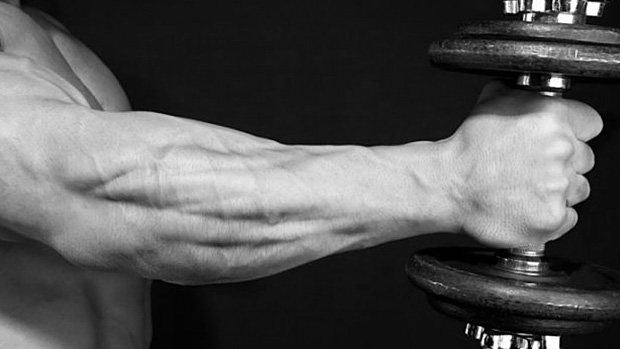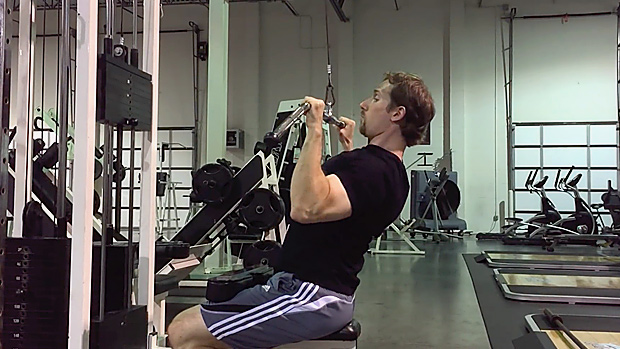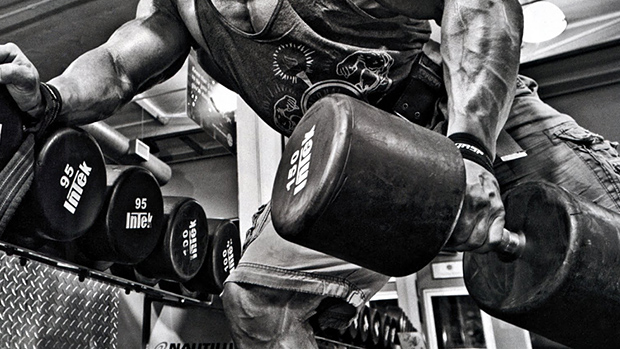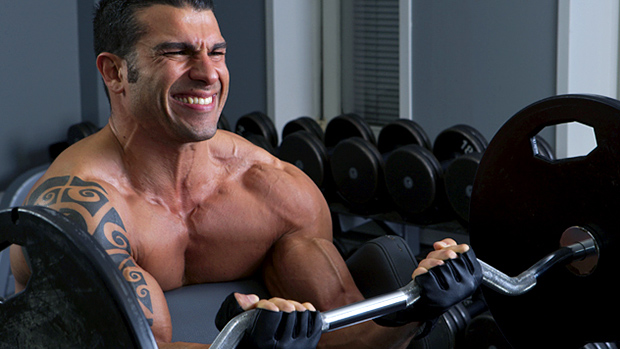Every male lifter – whether he's a serious bodybuilder, powerlifter, or mid-set texting gym rat – wants muscular arms. Those who disagree are either lying or lack testicular tackle.
But while peaked biceps and horseshoe triceps get the most attention – not to mention ink in the muscle magazines – what's even more impressive, at least to me, are massive forearms.
The current programming trend among strength coaches is more compound movements and less isolation exercises. An unfortunate result of this is a lack of direct forearm training – but I'm here to tell you if you want to maximize your development and improve your performance, you need to train your forearms and your hands!
Even if you aren't an athlete, a crushing grip is vital for your performance inside and outside the weight room. Forearm and grip training will help your heavy compound lifts like deadlifts and rows, in addition to lending an extra note of intimidation to an already muscular physique.
However, forearm training isn't just about adding a few wrist curls to the end of your workout. It's important to hit all areas of the forearms and all functions of the wrist, including direct hand and finger training.
For the majority of weight room exercises, the last link between you and the bar is your hands. The stronger your grip, the more weight you'll be able to control, leading to more growth.
This is especially true with pulling movements – if your grip is a limiting factor you'll never reach your size and strength potential.
To develop total hand strength and a set of freaky forearms, it's important to hit all the categories of grip and forearm training over the course of your training cycle.
For hand training, there's support, pinch, and crush. For forearm training, there's flexion/extension, ulnar/radial deviation, and pronation/supination.
Support
Training for support grip is among the most basic ways to train your forearms. If you're not doing any direct forearm training then this likely is the only grip training that you're doing.
Jim Wendler advocates high-rep back exercises like DB rows and barbell shrugs to train the grip, while Jim "Smitty" Smith suggests performing deadlifts with a double-overhand grip as long as you can before switching to an over-under grip.
Another tip from the pros is to hold each rep at the top of a deadlift for a few extra seconds to work the grip a little more, along with performing double overhand rack pulls and Romanian deadlifts.
A favorite support training method of mine is to perform a suitcase deadlift inside a power rack by grabbing the sleeve of a heavy barbell. Go head to head with a partner and hold for as long as you can until one guy quits! Make sure to hit both sides.
Still, the king of all support grip exercises is the farmer's walk. Picking up a heavy weight and carrying it does wonders for your forearms as well as your muscular endurance, not to mention making the whole body grow.
You can perform farmers walk's with a variety of implements such as dumbbells, kettlebells, farmer's handles, or even two barbells. If you're limited for space simply pick up the weight and hold for time to work your support grip.
To work your hands even more, an open-hand challenge can be added to any of the support exercises mentioned. You can go low tech and wrap a towel several times around a barbell or dumbbell to create a thick bar, or you can add a set of Fat Gripz or Grip4orce to any barbell.
The main difference between the Fat Gripz and the Grip4orce is the Grip4orce also has a crushing element (you need to actively close them) that makes them much harder. Try adding some thick-bar training to your pulling exercises to kill two birds with one stone.
Another side benefit of thick bar training is reduced stress on the shoulders and elbows because it disperses the force over a greater surface area.
Crush
Crush grip is what most people think of as hand training. A crushing grip is extremely important for barbell lifting since it's what creates the connection between your hands and the bar. The harder you grip the barbell, the stronger your connection will be and the more stable your set up will become.
This increased stability is also going to help keep stress off the shoulders when pressing and helps you maintain better technique. The stronger your connection to the bar, the better your form will be.
One of the best ways to train for crushing grip is with hand grippers. The problem is the particular gripper you buy is either way too easy or way too hard.
One tip I got from grip training expert Jedd Johnson is to use spring loaded grippers such as the Vulcan. This allows you to adjust the grippers to suit your individual strength level just like you would a barbell.
You can make incremental jumps by adjusting the spring up or down – you can even micro progress the gripper by adding rubber bands to the top of this device.
If you're serious about developing a crushing grip, my advice is to invest in a spring-loaded gripper. This way you only need to buy one device to progressively improve your hand strength and forearm development.
One of my favorite ways to train for crushing strength is rope climbing and hand-over-hand rope pulls. Every time you grab the rope you'll have to use your crushing strength to stabilize your body and hold onto the rope.
Rope climbing and hand over hand pulls are also an awesome to supplement your current back training, with the added benefit of grip strength.
If you don't have access to a high ceiling but have a rope, you can perform recline rope climbs with a partner or in a power rack.
For an added challenge, you can also try the double rope climb and set up the rope across a power rack as shown in the video below:
Big guys can get the same benefit by performing hand over hand pulls on a sled. Attach a rope to a sled and perform for time or distance.
If you don't have access to a sled, set up bands attached to a power rack and perform hand over hand pulls or supine "rope climbs."
Since not everyone has access to a rope, you can get the benefits of rope climbing by performing all forms of climbing on pull-up bars inside your power rack.
Another way to train for crushing grip is to use much thinner implements such as towels for pulling movements like pull-ups and rows. To keep a grip on the towel you need to constantly "crush" it so your hands don't slip off. This is a very low-tech solution that can really take your forearm training to the next level.
One of my favorite towel modifications is with T-bar rows as discussed in my perfect pulling exercises article. If your grip isn't quite ready for towel pull-ups, towel machine rows and inverted rows are another great options.
Wrist Postures
To have fully developed forearms, it's important to hit them from all angles and vary your direct forearm training on a regular basis.
Probably the most popular way to train forearms is with wrist curls and reverse wrist curls. The video below shows two variations of the basic wrist curl using dumbbells. Be sure to also do these from a pronated position to hit both sides of the forearm.
Perhaps my favorite way to train both wrist flexion and extension is by using a wrist roller. You can get a standard wrist roller or use bands and a barbell inside a power rack to eliminate shoulder contribution.
Make sure to perform the wrist roller in both directions to hit both sides and focus on the forearms doing the work by minimizing body English.
Check out the videos below, including a setup tutorial:
How to set up bands for a wrist roller:
Anti-Flexion Extension
Whenever you perform a pressing movement with a barbell, you're constantly fighting for neutral wrist position, which also works the forearms. It's also why world-class bench pressers tend to have bowling pins for forearms.
Another way to train this pattern is any bottoms-up kettlebell exercise. When you perform cleans, presses, and snatches with the base of the kettlebell up, you must fight to resist both flexion and extension. If you have access to kettlebells, make sure you perform some bottom up work from time to time to work this pattern.
Ulnar Radial Deviations
Ulnar and radial deviation is a forgotten forearm movement, but it's critical if you want to maximize your forearm potential. You can perform ulnar and radial deviation with the wrist roller setup mentioned in the previous section.
The videos below show how to perform it:
Another way to work this pattern is with a sledgehammer. You can even add a weight plate to the sledge if you want to increase the load. Make sure to perform the exercise from both directions.
Anti-Ulnar Radial Deviation
The ulnar and redial deviation work to resist movement when performing pressing exercises with a neutral bar. Neutral grip pressing is one way to effectively train these muscles.
Lifts like suitcase deadlifts, rack pulls, one-arm rows, and farmer's walks also work nicely. One-arm rows are discussed in my perfect pulling article and the suitcase rack pulls are found here.
Pronation/Supination
The last pattern of the wrist is pronation/supination. You can perform this movement by putting a kettlebell on its side while lying on the floor. Another way to train this is with a sledgehammer.
A really cool way to train your forearms and biceps at the same time is through dumbbell Zottman curls. Perform a neutral (supinated) dumbbell curl for the concentric phase of the movement and slowly lower with a reverse (pronated) grip. This allows you to go much heavier than a traditional reverse curl, but still get the forearm development benefit.
Pinch Grip and Finger Training
Pinch training is any grip exercise that directly opposes your thumb with your other fingers. It's also one of the most challenging forms of grip and forearm training.
One of my favorite ways to train the fingers and thumb is with dumbbell hex holds. If you have access to hexagon dumbbells, simply spread your fingers apart and pinch with your fingers and thumb while lifting the bell off of the ground and hold for time.
I first heard of this through Louie Simmons of Westside Barbell, and he said that it was one of their staple exercises to help the grip for the deadlift. You can perform several different exercises using the same methods such as bent over rows, Romanian deadlifts, farmers walks, curls, reverse curls, and loading the dumbbells onto a box for variety. Depending upon the exercise, you can hold for time or perform repetitions.
If you don't have access to hexagon dumbbells you can do simple plate pinches instead. These can range from basic one-arm plate pinches to curls and hand passes. You can vary the amount of plates and the size of the plates.
Weaker lifters can start off using five-pound plates, and more seasoned lifters can use a few tens and then progress to using 25s and even 45s for one and two-hand pinch work.
You can also use a sledgehammer to train the fingers for finger walking. This also improves finger dexterity. Dexterity is important for hand and finger health.
Other Hand Health Considerations
Some other considerations for hand health is to make sure you routinely perform soft tissue work on your hands and forearms by using a lacrosse ball, golf ball, or baseball. You can apply pressure manually or roll against a wall or bench to help promote recovery for the hands and forearms.
The last piece of advice for finger training and hand health is to make sure you perform some finger extension work with rubber bands or just with your body weight to balance out all the grip training you're doing.
Check out the videos below:
If you're performing grip exercises as a separate workout or on off days, it's important to include some warm ups before you start.
Just going through basic unloaded wrist movements such as flexion, extension, ulnar deviation, radial deviation, wrist circles, and finger abduction and extension will help prepare your wrists, fingers, and forearms for the workout.
Summing Up
- Perform double-overhand deadlifts, Romanian deadlifts, and rack pulls as heavy as possible before switching to an over-under grip.
- Perform high rep pull-ups or rows to work grip endurance and support grip.
- Add crush-grip training with hand grippers to improve your connection and stability for all heavy compound movements.
- Make sure to directly train the forearms with a variety of movements to ensure total forearm development.
- Occasionally perform heavy lat/upper back exercises with either a thick grip device or towel to get in some extra hand and forearm training.
- Hit some pinch training at the end of your workout with hex dumbbells or plates to work your thumbs and hands.
- Whenever possible, use fat bars, towels, sledgehammers, and ropes to perform assistance work for the hands, forearms, and other muscles.
- Make sure to perform soft tissue work on the hands and forearms as well as rubber band extensor work to ensure your grip training isn't affecting your main routine.
Get A Grip!
Isolation training isn't popular nowadays, but direct forearm and hand training can improve your physique as well as your strength and performance. Strong forearms and hands allow for better stability and control during all basic compound movements, so make sure to try to incorporate some grip training either within your workout or at the end of the session.





